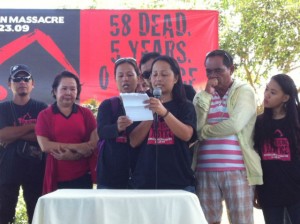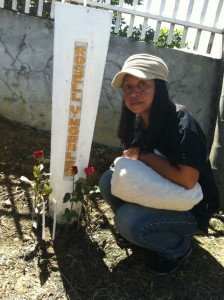
Ampatuan massacre: Five years of delayed justice
On 23 November 2009, 58 people of whom 32 were journalists were assassinated on a hillside in the Philippino province of Maguindanao in what became the single deadliest event for journalists in history. Five years on, still no one has been convicted. IMS joins the fifth year commemoration of the Ampatuan massacre
By Helle Wahlberg, IMS
Maize and young palm trees sway peacefully in the wind on a pretty hillside on the outskirts of Ampatuan town on the island of Mindanao. Only the many people quietly perusing the hillside placing with lit candles accompanied by the softspoken prayers of the Catholic priests present in this remote spot, reveal that this is no ordinary place.
This is the location at which 58 people of whom 32 were journalists met their death in an incident of election-related violence tied to a dispute between two powerful political clans, the Ampatuan and Mangudadatu families. The group was travelling in a convoy of cars to Maguindanao to file the certificate of candidacy of Esmael Mangudadatu, for the 2010 elections and were stopped at a check point, then led off the main road down a dirt path in their cars by uniformed men. Over the next four hours, all 58 were shot and thrown into thre pre-dug mass graves.
From empty promises to impunity
The massacre sparked outrage around the world and set the record for the highest number of journalists killed in one incident. However, five years on, 196 individuals, including police officers, militiamen and members of the Ampatuan family stand accused of planning and carrying out the massacre, but no one has been convicted. In addition, two witnesses were killed earlier this month as they prepared to testify.
The then incoming President Aquino made a promise during his election campaign to bring the culprits to justice. According to evidence discussed in court, some of these culprits had already been identified by text messages sent by the victims to relatives shortly before their assassination, when realising that something was not right.
“President Aquino promised a quick trial for the culprits, but did not deliver on his promises. In fact, in his term, 33 more journalists lost their lives. There is a problem with our judicial system, and the one we have today is the same corrupt one we had five years ago,” said Nonoy Espina, director of the National Union for Journalists in the Philippines (NUJP) to the crowd at the commemoration event.

Assembled at the site of the massacre to mark the five year anniversary were local journalists who lost colleagues, journalist union members, representatives of organisations such as IMS and family members who continue to campaign for justice.
“I was there on the second day of recovering the bodies,” says local journalist Roland Ortillano who was 23 at the time and covering the story for Brigada News Philippines, a local newspaper.
“Diggers were unearthing the three mass graves at the site into which both cars and bodies had been dumped. It was hard to get an overview, and there were bodies scattered everywhere. What I especially remember is seeing the faces of a reporter and a cameraman that I had met only two days before at a press conference about the murder of another media worker. The cameraman was about my age.”
The sudden death of 32 journalists left a major void in the local community, according to Roland Ortillano.
“We were fewer and there was less coverage. The fear accompanying the work as a journalist grew stronger because those involved stayed in power. But the incident also brought the media community across the Philippines closer together and was a lesson learnt to take precautions. Perhaps, if the journalists on that trip had gone through safety training they would have been more prepared and known to investigate the area they would travel through, through intelligence reports.”
Building the safety of journalists in Mindanao
In 2010 in the immediate aftermath of the Ampatuan massacre, the National Union of Journalists (NUJP) in the Philippines together with IMS, Open Society Foundation and International Federation of Journalists set up an office on the island of Mindanao to address the serious safety concerns facing journalists. The staff provided safety training, psyclological and trauma counselling to journalists and relatives left behind, an education scholarship for the orphaned children and advocated for the authorities to crack down on the perpetrators.
For many of the widows and other family members left behind, the NUJP became an important ally. Amongst those for whom the assistance of NUJP continues to be crucial in her struggle for justice and during a time of grieving and financial stress, is Mary Grace Morales who lost both her husband Rosell Morales and her sister, both journalists, in the massacre.

Visibly taxed by the vivid memories brought back on the anniversary, she explains:
“When my husband was killed, I was a home wife and had no income to support my three daughters who were 10, 8 and five at the time. The NUJP played an important role in providing moral support by helping to bring together the families and supporting our campaigning, by providing a scholarship programme for the children which enabled me to send all three of my daughters to school.”
Together with the other families, Grace Morales set up the volunteer organisation “Justice Now” in2010, which campaigns for the authorities to bring to justice those who committed the massacre and most of all, to ensure that the massacre is not forgotten.
In January 2015, the Pope is set to visit the Philippines. In a letter, the families urge him to raise their issue and demand justice from the President.
“We are hopefull,” she says. “But we also fear that the witnesses will be killed before they have a chance to talk.”
23 November is the fifth anniversary of the Ampatuan massacre. In 2009, IMS was part of the first international investigative mission to the site together with the International Federation of Journalists and the National Union for Journalists in the Philippines. Read about their findings in the report: Massacre in the Philippines (December 2009).
The Philippines remains one of the most dangerous places in the world for journalists and ranks third in Committee to Protect Journalists’ impunity ranking of countries failing to resolve journalist murders. Read more here.




